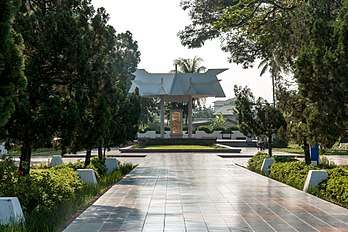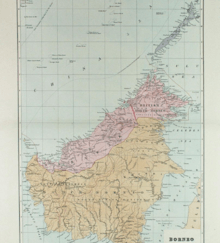Jesselton revolt
| Jesselton revolt | |||||||
|---|---|---|---|---|---|---|---|
 Some names of resistance movement members aside from the main group who were subsequently executed after the revolt. | |||||||
| |||||||
| Belligerents | |||||||
| Kinabalu Guerillas Defence Forces |
• Occupied British Borneo | ||||||
| Commanders and leaders | |||||||
|
|
| ||||||
| Units involved | |||||||
|
Limited arms support: |
• Kenpeitai | ||||||
| Strength | |||||||
|
100 Chinese ≈200 Bornean/Philippine indigenous peoples[note 1]/Eurasian/Sikh Indian |
≈Hundreds Japanese police (1943) ≈Thousands Japanese troops (post 1943) | ||||||
| Casualties and losses | |||||||
| 324 resistance members killed | 50–90 soldiers killed[note 2] | ||||||
| 2,000–4,000 civilians massacred by the Japanese | |||||||
The Jesselton revolt (also known as Jesselton uprising or Double Tenth Revolt/Incident) was a revolt by a resistance movement known as the Kinabalu Guerrillas, comprising local Chinese, indigenous peoples, Eurasian and Sikh Indian of Jesselton, North Borneo and led by Albert Kwok, against the Japanese occupying forces of North Borneo.
The movement succeeded in killing around 50–90 Japanese soldiers and temporarily took control of the North Borneo capital and several neighbouring districts of Tuaran and Kota Belud. But, owing to limited arms supplies, the movement was forced to retreat into its hide-out. The Japanese Kenpeitai then launched attacks against coastal settlements in western North Borneo to find the leader and members of the guerrilla force, with many innocent civilians suffering the most serious consequences.
The leader of the revolt finally decided to surrender following Japanese threats to execute more civilians if the guerrillas did not turn themselves in. Following their arrest and subsequent execution, the Japanese returned to administer North Borneo until 1945 when the main Allied liberation mission arrived.
Background
With the persistent harsh rule during the Japanese occupation, there have been some resistance against the Japanese especially on the west coast of North Borneo, where a revolt were led by Albert Kwok with the members comprising mostly Chinese and some indigenous peoples.[1][2] Kwok, a local Teochew Chinese from Kuching in neighbouring Sarawak had previously working with the China Red Cross and serving under Kuomintang of Chiang Kai-shek,[3][4] before returning to Borneo through Malaya in 1940.[5][6] During his time in China, Kwok was also a student of the Seventh-day Adventist Mission School in Canton. He arrived on Jesselton on 15 May 1941 and started a practice treating piles.[4][7]
In February 1942, Kwok want to establish contact with the Australians or Americans in eastern North Borneo but was unable to walk across the island jungle more further when he reached Pensiangan where he saw a large presence of Japanese troops.[3] He needed to establish relations with the Allied movements, especially the United States Forces in the Philippines (USFIP) as it is the only sole armed resistance movement in the region at the time which are supplied with firearms.[8] After he managed to establishing contact with the American forces in the Philippines with the help of fellow Chinese businessman named Lim Keng Fatt,[8][9] a Muslim cleric (Imam) named Marajukim from Sulu who is part of the resistance movement in the Philippines approached Kwok in Jesselton where he began to depart to Tawi-Tawi for training.[10] From there, they travel further to Sulu and met Lieutenant Colonel Alejandro Suarez and learned the activities of the resistance movement in the archipelago.[8][11][12]
In May 1943, Kwok returned to Jesselton with a high determination to liberate North Borneo. Once he arrived there, he first contacted the Overseas Chinese Defence Association (OCDA), with whose help he acquired medical equipment and cash donations for the support of the resistance in Sulu.[13] Once again, in June 1943, he travelled with Marajukim to the Philippines. Through the mediation of Suarez, he met with the representatives of the US army and was appointed Lieutenant on 1 July 1943.[14] The second time he returned to North Borneo, Kwok already got three pistols, a box of hand grenades and was promised to be given more weapons.[15] However, as he could not induce the guerrillas in the Sulu Archipelago to send more firearms, he was forced to launch a revolt with limited supplies.[16] A resistance group under his leadership was then established on 21 September 1943, with the group calling themselves as the Chinese National Salvation Association (CNSA),[17] a branch of the OCDA.[16] With collaboration between the Chinese and indigenous peoples, the group were subsequently known as Kinabalu Guerrillas Defence Force.[11][18]
Uprising

As the Japanese decree to seize any opposition towards the Japanese administration became closer, the resistance group were forced to launch revolt ahead of schedule. With much of his members armed with only parang, spear and kris,[19] the movement launched their attack from 9 October 1943 and temporarily retake Jesselton, Tuaran and Kota Belud, leaving around 50–90 casualties on the Japanese side.[20][21][22] Through a combined land and sea attack on the Japanese, most islands inhabitants around the coastal areas contributed ships to the movement. Native Bajau-Suluk leaders such as Panglima Ali (Sulug Island), Jemalul (Mantanani Islands), Orang Tua Arshad (Udar Island) and Saruddin (Dinawan Island) contributed mostly through sea attacks.[23]
Both Jemalul and Saruddin volunteered themselves from the Philippines to led the Binadans of Mantanani and the Dinawan Islands.[24] From land, the movement been supported by native Dusun-Murut leaders such as Musah representing the Dusun community and Duallis for the Murut as well members of Indian Imperial Police led by Constable Subedar Dewa Singh.[23] While administration and police members of authorities of North Borneo mostly serving under the North Borneo Volunteer Force (NBVF) led by Jules Stephens and Charles Peter,[23] as well as Sergeant Bud Singh and Corporal Sohan Singh.[25]
After the successful revolt, the resistance movement under OCDA and NBVF jointly hoisting the flag of the Republic of China and Union Jack on 10 October 1943.[8] Most of the members under OCDA are loyal to the Republic of China while NBVF remained loyal to the United Kingdom although the NBVF are not even recognised by the British government.[8] While the Japanese reinforcement from Kuching are still in process, Kwok along with other members began to retreat into their hide-out and the OCDA celebrate the birthday of Sun Yat-sen, the founder of Kuomintang and subsequently the Republic of China by hoisting the national flag again and singing the national anthem of the Republic of China on 12 November 1943.[8]
Aftermath and legacy

Following the arrival of Japanese reinforcement, the Japanese authorities subsequently launch a ruthless counter-offensive by bombing coastal settlements from Kota Belud until Membakut and machine-gunning people.[22][26] Almost all villages in the area burnt down with around 2,000–4,000 innocent civilians were executed, mostly being the Bajau-Suluk civilians.[27][28] After been threatened with more civilians will be killed if the leader of the uprising did not turned themselves in, Kwok finally surrendered with several of his top members where he and some 175 peoples who for the most part had nothing to do with the uprising are subjected to execution order of the Japanese on 21 January 1944 in Petagas, Putatan.[17]
After the war, the International Military Tribunal for the Far East (IMTFE) that was set-up in 1946 concludes that during the resistance movement that was led by the Chinese and indigenous peoples in North Borneo, the Kenpeitai are involved in the reign of terror by arresting, torturing and massacre hundreds of Chinese revolt members while doing an apparently systematic extermination of coastal population that was inhabited by the Suluk people.[29][30] The sacrifice of the movement was honoured with a memorial in Petagas.
Notes
Footnotes
- ↑ Tarling 2001, pp. 196.
- ↑ Ham 2013, pp. 166.
- 1 2 Tregonning 1960, pp. 88.
- 1 2 Danny 1998, pp. 154.
- ↑ Goodwin 1953, pp. 31.
- ↑ Evans 1990, pp. 50.
- ↑ Julitta 2005, pp. 312.
- 1 2 3 4 5 6 Kratoska 2013, pp. 124.
- ↑ Reece 1998, pp. 162.
- ↑ Julitta 2005, pp. 318.
- 1 2 Evans 1990, pp. 52.
- ↑ Dick 1983, pp. 55.
- ↑ Evans 1990, pp. 51.
- ↑ Julitta 2005, pp. 328.
- ↑ Kratoska 2013, pp. 125.
- 1 2 Tregonning 1960, pp. 89.
- 1 2 Danny 2004, pp. 116.
- ↑ Kratoska 2013, pp. 128.
- ↑ Abbas & Bali 1985, pp. 159.
- ↑ Kratoska 2013, pp. 111.
- ↑ Luping, Chin & Dingley 1978, pp. 40.
- 1 2 Ooi 1999, pp. 56.
- 1 2 3 Ooi 2010, pp. 164.
- ↑ Dick 1983, pp. 47.
- ↑ Hwang 2010.
- ↑ Ooi 2010, pp. 186.
- ↑ Ooi 2013, pp. 77.
- ↑ Kratoska 2013, pp. 113.
- ↑ Watt 1985, pp. 210.
- ↑ Thurman & Sherman 2001, pp. 123.
References
- Goodwin, J. W. (1953). Eastern World. Far Eastern.
- Tregonning, K. G. (1960). North Borneo. H.M. Stationery Office.
- Luping, Margaret; Chin, Wen; Dingley, E. Richard (1978). Kinabalu, Summit of Borneo. Sabah Society.
- Dick, Crofton Horton (1983). Ring of fire: Australian guerrilla operations against the Japanese in World War II. Secker & Warburg. ISBN 978-0-436-20157-8.
- Abbas, Ismail; Bali, K. (1985). Peristiwa-peristiwa berdarah di Sabah (in Malay). Institute of Language and Literature, Ministry of Education (Malaysia).
- Watt, Donald Cameron (1985). The Tokyo War Crimes Trial: Index and Guide. International Military Tribunal for the Far East. Garland. ISBN 978-0-8240-4774-0.
- Evans, Stephen R. (1990). Sabah (North Borneo): Under the Rising Sun Government. Tropical Press.
- Danny, Wong Tze-Ken (1998). The Transformation of an Immigrant Society: A Study of the Chinese of Sabah. Asean Academic. ISBN 978-1-901919-16-5.
- Reece, Bob (1998). Masa Jepun: Sarawak Under the Japanese, 1941-1945. Sarawak Literary Society. ISBN 978-983-9115-06-2.
- Ooi, Keat Gin (1999). Rising Sun over Borneo: The Japanese Occupation of Sarawak, 1941–1945. Palgrave Macmillan UK. ISBN 978-1-349-27300-3.
- Tarling, Nicholas (2001). A Sudden Rampage: The Japanese Occupation of Southeast Asia, 1941-1945. C. Hurst & Co. Publishers. ISBN 978-1-85065-584-8.
- Thurman, Malcolm Joseph; Sherman, Christine (2001). War Crimes: Japan's World War II Atrocities. Turner Publishing Company. ISBN 978-1-56311-728-2.
- Danny, Wong Tze-Ken (2004). Historical Sabah: The Chinese. Natural History Publications (Borneo). ISBN 978-983-812-104-0.
- Julitta, Shau Hua Lim (2005). Pussy's in the well: Japanese occupation of Sarawak, 1941-1945. Research and Resource Centre, SUPP Headquarters. ISBN 978-983-41998-2-1.
- Ooi, Keat Gin (2010). The Japanese Occupation of Borneo, 1941-45. Routledge. ISBN 978-1-136-96309-4.
- Hwang, Andrew (2010). "Remember the North Borneo resistance fighters". The Star. Archived from the original on 24 October 2017.
- Ham, Paul (2013). Sandakan. Transworld. ISBN 978-1-4481-2626-2.
- Kratoska, Paul H. (2013). Southeast Asian Minorities in the Wartime Japanese Empire. Routledge. ISBN 978-1-136-12514-0.
- Ooi, Keat Gin (2013). Post-war Borneo, 1945-50: Nationalism, Empire and State-Building. Routledge. ISBN 1-134-05803-9.
Further reading
- Maxwell, J. Hall (1965). Kinabalu Guerrillas: An Account of the Double Tenth 1934 [i.e. 1943]. Borneo Literature Bureau.
- Brooks, Ronald J. (1995). Under Five Flags. Pentland Press. ISBN 978-1-85821-322-4.
- Danny, Wong Tze-Ken (2006). "The Kinabalu Guerrillas in Local and National History" (PDF). Sabah Society Journal. Department of History, Faculty of Arts and Social Sciences, University of Malaya. pp. 19–30. Archived from the original (PDF) on 24 October 2017.
- Danny, Wong Tze-Ken (2007). "The Petagas War Memorial and the Creation of a Heroic Past in Sabah". Journal of the Malaysian Branch of the Royal Asiatic Society. 80: 19–32. JSTOR 41493694.
- Ooi, Keat Gin (2010). "The Japanese Occupation of Borneo, 1941–1945" (PDF). Routledge. ISBN 0-203-85054-8. Archived from the original (PDF) on 25 October 2017.
- Daily Express (2013). "Granddaughter seeks apology for massacre". Daily Express. Archived from the original on 18 October 2017.
- Lajiun, Jenne (2015). "Relatives share stories of Sabah fallen heroes". The Borneo Post.
- Daily Express (2015). "Albert Kwok's daring raid". Daily Express. Archived from the original on 24 October 2017.
- Daily Express (2017). "82-year-old recalls execution of hero dad in Petagas". Daily Express. Archived from the original on 28 October 2017.

